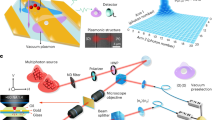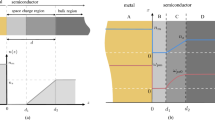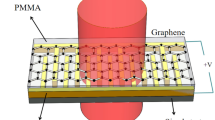Abstract
When light interacts with metal surfaces, it excites electrons, which can form propagating excitation waves called surface plasmon polaritons. These collective electronic excitations can produce strong electric fields localized to subwavelength distance scales1, which makes surface plasmon polaritons interesting for several applications. Many of these potential uses, and in particular those related to quantum networks2, require a deep understanding of the fundamental quantum properties of surface plasmon polaritons. Remarkably, these collective electron states preserve many key quantum mechanical properties of the photons used to excite them, including entanglement3,4 and sub-Poissonian statistics5. Here, we show that a single-photon source coupled to a silver nanowire excites single surface plasmon polaritons that exhibit both wave and particle properties, similar to those of single photons. Furthermore, the detailed analysis of the spectral interference pattern provides a new method to characterize the dimensions of metallic waveguides with nanometre accuracy.
This is a preview of subscription content, access via your institution
Access options
Subscribe to this journal
Receive 12 print issues and online access
$259.00 per year
only $21.58 per issue
Buy this article
- Purchase on SpringerLink
- Instant access to full article PDF
Prices may be subject to local taxes which are calculated during checkout



Similar content being viewed by others
References
Barnes, W. L., Dereux, A. & Ebbesen, T. W. Surface plasmon subwavelength optics. Nature 424, 824–830 (2003).
Chang, D. E., Sørensen, A. S., Demler, E. A. & Lukin, M. D. A Single-photon transistor using nanoscale surface plasmons. Nature Phys. 3, 807–812 (2007).
Altewischer, E., van Exter, M. P. & Woerdman, J. P. Plasmon-assisted transmission of entangled photons. Nature 418, 304–306 (2002).
Fasel, S. et al. Energy-time entanglement preservation in plasmon-assisted light transmission. Phys. Rev. Lett. 94, 110501 (2005).
Akimov, A. V. et al. Generation of single optical plasmons in metallic nanowires coupled to quantum dots. Nature 450, 402–406 (2007).
Loudon, R. Non-classical effects in the statistical properties of light. Rep. Prog. Phys. 43, 913–949 (1980).
Aspect, A. & Grangier, P. Wave-particle duality for single photons. Hyperfine Interactions 37, 3–18 (1987).
Grangier, P., Roger, G. & Aspect, A. Experimental-evidence for a photon anticorrelation effect on a beam splitter—a new light on single-photon interferences. Europhys. Lett. 1, 173–179 (1986).
Zia, R. & Brongersma, M. L. Surface plasmon polariton analogue to Young’s double-slit experiment. Nature Nanotech. 2, 426–429 (2007).
Ford, G. W. & Weber, W. H. Electromagnetic-interactions of molecules with metal-surfaces. Phys. Rep. 113, 195–287 (1984).
Chang, D. E., Sørensen, A. S., Hemmer, P. R. & Lukin, M. D. Quantum optics with surface plasmons. Phys. Rev. Lett. 97, 053002 (2006).
Fedutik, Y., Temnov, V. V., Schops, O., Woggon, U. & Artemyev, M. V. Exciton-plasmon-photon conversion in plasmonic nanostructures. Phys. Rev. Lett. 99, 136802 (2007).
Temnov, V. V., Woggon, U., Dintinger, J., Devaux, E. & Ebbesen, T. W. Surface plasmon interferometry: Measuring group velocity of surface plasmons. Opt. Lett. 32, 1235–1237 (2007).
Allione, M., Temnov, V. V., Fedutik, Y., Woggon, U. & Artemyev, M. V. Surface plasmon mediated interference phenomena in low-Q silver nanowire cavities. Nano Lett. 8, 31–35 (2008).
Ditlbacher, H. et al. Silver nanowires as surface plasmon resonators. Phys. Rev. Lett. 95, 257403 (2005).
Laroche, T. & Girard, C. Near-field optical properties of single plasmonic nanowires. Appl. Phys. Lett. 89, 233119 (2006).
Chang, D. E., Sorensen, A. S., Hemmer, P. R. & Lukin, M. D. Strong coupling of single emitters to surface plasmons. Phys. Rev. B 76, 035420 (2007).
Gordon, R. Vectorial method for calculating the Fresnel reflection of surface plasmon polaritons. Phys. Rev. B 74, 153417 (2006).
Gruber, A. et al. Scanning confocal optical microscopy and magnetic resonance on single defect centers. Science 276, 2012–2014 (1997).
Childress, L. et al. Coherent dynamics of coupled electron and nuclear spin qubits in diamond. Science 314, 281–285 (2006).
Gaebel, T. et al. Room-temperature coherent coupling of single spins in diamond. Nature Phys. 2, 408–413 (2006).
Bonifacio, R. & Morawitz, H. Cooperative emission of an excited molecular monolayer into surface-plasmons. Phys. Rev. Lett. 36, 1559–1562 (1976).
Temnov, V. V. & Woggon, U. Superradiance and subradiance in an inhomogeneously broadened ensemble of two-level systems coupled to a low-Q cavity. Phys. Rev. Lett. 95, 243602 (2005).
Durach, M., Rusina, A., Klimov, V. & Stockman, M. Nanoplasmonic renormalization and enhancement of Coulomb interactions. New J. Phys. 10, 105011 (2008).
Dutt, M. V. G. et al. Quantum register based on individual electronic and nuclear spin qubits in diamond. Science 316, 1312–1316 (2007).
Neumann, P. et al. Multipartite entanglement among single spins in diamond. Science 320, 1326–1329 (2008).
Korte, K., Skrabalak, S. & Xia, Y. Rapid synthesis of silver nanowires through a CuCl- or CuCl2-mediated polyol process. J. Mater. Chem. 8, 437–441 (2008).
Johnson, P. B. & Christy, R. W. Optical-constants of noble-metals. Phys. Rev. B 6, 4370–4379 (1972).
Acknowledgements
We would like to thank Ralf Vogelgesang for helpful discussions. This work was supported by the EU (QAO, EQUIND, NEDQIT), DFG (SFB/TR21 and FOR730), Landesstiftung BW, NIH and DARPA.
Author information
Authors and Affiliations
Contributions
R.K., B.G., G.B., R.J.S. and A.A.L.N. carried out the experiments; P.R.H., F.J. and J.W. designed and coordinated the experiments; and F.J. wrote the paper. All authors discussed the results, analysed the data and commented on the manuscript.
Corresponding authors
Supplementary information
Supplementary Information
Supplementary Information (PDF 374 kb)
Rights and permissions
About this article
Cite this article
Kolesov, R., Grotz, B., Balasubramanian, G. et al. Wave–particle duality of single surface plasmon polaritons. Nature Phys 5, 470–474 (2009). https://doi.org/10.1038/nphys1278
Received:
Accepted:
Published:
Issue date:
DOI: https://doi.org/10.1038/nphys1278
This article is cited by
-
Detection of a plasmon-polariton quantum wave packet
Nature Physics (2023)
-
Surface Plasmons Enhanced Quantum Interference
Plasmonics (2023)
-
Conductivity Dependent Sensitivity of the Surface Plasmon Polariton Waves at the Interface of Metal and Dielectric Using Wavelength Interrogation
Plasmonics (2023)
-
Volume fractional change of nano-particle for enhanced localization probability in surface plasmon polariton dispersion relation at AgSiO2-cesium atomic interface
Optical and Quantum Electronics (2023)
-
Empowering magnetic strong coupling and its application for nonlinear refractive index sensing
Nano Research (2022)



